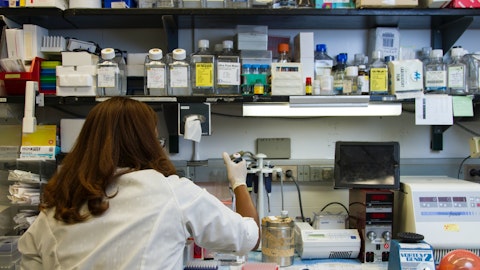Emil Kakkis: chronic dosing for OI. Okay. Why do we believe we can get chronic dosing? Well, we know that you probably need it. First of all, osteoporosis and osteogenesis imperfecta are very different diseases. They are very different diseases, particularly the age of the patients, the state of their bone and the biology of their bone disease. What we know from the asteroid study that was conducted [indiscernible] is that when they took them off the setrusumab and put them on just bisphosphonates, they were losing bone real density, their bones were turning back around the direction they gained. It’s clear that you need chronic dosing. What we know now from treating patients chronically because we had, including one kid that we showed you, months of treatment as they continue to gain ground and do better and better.
So everything we say said in the OI indication, their bones are different, and for particularly they’re younger and they have an induction effect from their genetic disease that makes them different. By stimulating, we’re able to maintain their bone all density or [indiscernible] further. And what we do believe there may be a point at which we need to move to maintenance dosing where you don’t need to make their bones more dense. And at that point, we’ll look at going into a less frequent maintenance dosing regimen.
Operator: And one moment for our next question. And that will come from the line of Yaron Werber with Cowen.
Brendan Smith: This is Brendan on for Yaron. First, just another quick one on San Filippo. I understand talks with if you are still ongoing. But just wondering when you think you might know and be able to make a decision on timing to regulatory filing and whether based on how those talks are going to expect that could happen this year. And then just really quickly on GSD1a. I wanted to see how soon after the Q2 readout you expect to be able to file. Has FDA given you really any confirmation on how long they want you to follow these patients after that primary endpoint, just to understand durability or what have you, just before you get that submitted?
Emil Kakkis: So for MPS IIIA, the workshop coming up, I think, will be an important touch point. And I’d expect that after that, I would assume this first half will have a read on whether we could file off of the biomarker-based data. I will tell you that we’ve collected almost enough clinical data to be able to follow up clinical data alone. However, we think it’s more meaningful to built et approval in the biomarker, but we should know this first half. The workshop being an important moment, but the follow-up meeting that may occur with the review division, then will let us know what our path is either way we can find a way forward for MPS IIIA, we just think it’s better for the field, both us and the field if we are able to get accelerated approval and open the door now to treating more ultra-rare diseases.
For GSD1a readout, we haven’t put a time line for filing. We have noted our plan to bring the manufacturing in-house, which will require some time, but we are — that will be an important part of what we have to do. But we’ll have to go and meet with the FDA to understand from a pre-BLA meeting more precisely what is expected in all the different packages, the CMC package and the rest of it. And so that will help determine what happens. But we’re — if the data are positive, which we expect we’ll be working to move toward a filing as diligent as we can given the parameters I’ve said.
Operator: One moment for our next question, and that will come from the line of Kristen Kluska with Cantor Fitzgerald.
Kristen Kluska: So with the Phase II setrusumab data guided for the second half of the year, I think that puts you at mean of at least 1.5 years worth of follow-up. So I wanted to ask if there’s anything that you’re going to be looking for beyond fracture prevention, which, of course, is the essential goal. But then also to your comments earlier about chronic dosing. What do you think about in OI and chronic dosing in general, if there could be further improvement or even preventing further impact as it relates to some of the other features of OI such as the deformities of bone structure, et cetera?
Emil Kakkis: Yes. So you’re right. I think that we’re probably in that range of 1.5 years. And if you could say like the patient we described it had 17 months treatment. He wasn’t using wheelchair anymore and he’s running around and playing. I think that’s kind of what we’re hoping for is to look at those secondary clinical signs that not only a reduction of fractures, but people feel better or more active and still not having fractures. So we’re going to look for that clinical meaningful side of the story as well in those patients. Our thinking, and this relates to the maintenance dosing, is that if we improve the bone density sufficiently so that they stop having fractures and have very few fractures, and we expect two things to happen.
We should be able to go to maintenance dosing where we give tetrizumab every two or three months, it allows us to maintain the bone density that they have and not lose [indiscernible]. But we’d also expect that when you stop having fracture, you will stop having progressive deformity and in particularly the place we’re most interested in is in the spinal column. The spinal column degeneration is absolutely the most devastating part of OI, particularly type three and 4, the one in the wheelchairs who lives are devastated, preventing the fortrebral fractures, which we hope to be able to see at that point in time would be the kind of thing that would prevent the deformity of their spines, the decline in spinal function and the wheel — becoming wheelchair bound.
Those are the kind of things which are — can change the future. It’s partly why we’re running the COSMIC study in the 2- to 4-year old to try to capture that result. So when we head to a filing for approval, we can establish a new scanner for care that you need to be treating OI patients with setrusumab at a young age to help prevent the deformities going forward. So hopefully, the case that will add to that question that you’ve asked about changing deformities. If you can do that could be that you could stop OI type three and four ending wheelchair-bound and what a terrific result that would be, and that’s what we think both what we’ve seen so far.
Operator: One moment for our next question. And that will come from the line of Salveen Richter with Goldman Sachs.
Lidia Rachkova: This is Lidia on for Salveen. So we just have one on UX701, could you just help us frame the clinical update expected this year, specifically around how much proof of concept we could expect here?
Emil Kakkis: Yes. So the concept — the information you’re going to get are five patients at three doses, right? So it’s still a relatively small set to data. What we’d be looking to see is can we eliminate the need in at least some patients for chelators that as we can remove their chelators and still maintain urinary copper that is we can replace the chelators, the second thing is can we restore copper distribution, that is a place where the gene therapy can exceed what you obtain with chelators. Because we didn’t get into the Wilson gene therapy business just to replace chelators letters just to get rid of a treatment. We got in there because we think you can have a more profound beneficial treatment that restores copper distribution as well as detoxification.
So we’d want to be able to show that both of those things are happening. If we can show that both of those are happening, patients at the optimal dose is done with safety, it sets us up for immediately rolling a Phase III study at that dose and regimen that will allow us then to potentially work with the disease. The stronger the benefit of the copper distribution on their outcomes and the more likely the drug will become adopted by a larger fraction of Wilson patients. If it’s we’re great at moving the toxicity. And then it could be the 20%, 30% of the patients that are not tolerant chelators very well that it would be beneficial. And our expectation, though, that could be more beneficial than you might imagine, given what’s known about chelators and that will open the door to having a larger fraction Wilson patients that would respond.
So it will give us at least the beginning framing of those two aspects of the Wilson Disease. But remember, there’s only five patients per group. So we cannot expect to have definitive clinical outcome results in that grouping to tell us the answer. But with the Phase III study, following that, we’d have enough patients in there to start to say something more about the clinical meanfulness or the secondary neurologic effects, otherwise, that you might obtain by having restoration of copper distribution.
Operator: One moment for our next question. And that will come from the line of Yigal Nochomovitz with Citi.
Ashu Kumar: This is Ashu Kumar on for Yigal. I had a follow-up on earlier Angelman discussion. I guess as you’re thinking through the various scenarios between a more novel end point for Phase III versus a more traditional endpoint. I’m curious how you think the expansion data, you’re planning on sharing with is you might capture the potential for a more novel end point. And if you lean towards the more novel end of the spectrum and you take that to regulators, is there maybe potential that you need to generate additional data beyond this expansion cohort to submit before you start the Phase III? I’m just curious how you’re thinking about that.
Emil Kakkis: Yes. Well, our focus — I mean, I think our focus in terms of endpoint choice is going to be the main ones we’ve already shown that we’ve tested before and we’re adding to. We’re not necessarily expecting a brand new endpoints to come out. But — so it will be dependent primarily on what we see. The thing that will happen in the study though is that we’ll get a large number of patients loaded the same way, right, which we haven’t had, which will give us a better or more precise estimate of the change we see and have it be more reliable, not wishful thinking, but to see a large number of patients showing a very similar pattern of result. Our goal expectations are from the end points, we’ve talked about five domains, which the daily was for three of those domains and two other endpoints for the behavior and sleep.
Those are going to be the core five domains that we’re going to be working with. There will be other assessments for fine motor and express and communication. But the five we’ve talked about will be the main drivers. So I don’t really think there’s going to be a point where we’re going to start fresh with a new endpoint and restart over. That’s not something we need to do. We think we have enough data among the ones we know to come up with a good conclusion and structure the endpoints in a way that gives us the best insight on how the drug works and gets regulatory agreement. But we certainly wouldn’t want to start off fresheners discussion. We do believe we’ll have enough to make that conclusion with the agency.
Operator: One moment for our next question. And that will come from the line of Jeff Hung with Morgan Stanley.
Jeffrey Hung: For UX-111, you mentioned that you’ve collected almost enough clinical data to file off the clinical data alone. What length of long-term follow-up do you need to accurately measure potential for improved development with sustained HS normalization how should we think about the time course for development?
Emil Kakkis: Well, this is one of the areas for discussion with the agency. Originally, they had told Abeona and in our discussions had a requirement to see at least patients reach age five years. However, we’ve been able to show that between 24 months and 60 months, between in that period, there is the most rapid decline normally in natural history. And then if you look at the estimated yearly change in development and the trajectory of development, you can readily distinguish patients during that period. We have a number of patients now that have already gone past 60 months or five years. But between 48 and 60 there are a number of others that are also showing good development. And we think the combination of those patients may be already enough clinically to demonstrate the benefit, which was part of that update.
But we’re working to understand in our new analysis, we showed on this estimated yearly change in relationship to area on the curve exposure helps provide better insight into how to understand trajectory of elements over time. And we think this means we can interpret better what’s happening between, let’s say, three months of age and 60 months of age to know what is the trajectory of a patient with sample to that’s untreated. And what’s the trajectory of someone who has adequate heparan sulfate reduction. And so those will be what we’ll be pressing for. But even just patients from 48 to 60 months, a minimum of 48, 60 months, we already have clinical data saying the drug is effective. So it is another way for us to go forward, but far more valuable to get an accelerated approval to include all the data and all the patients and accept the 48 to 60 minimum treatment data is simply evidenced toward the reasonably likely predict standard.





